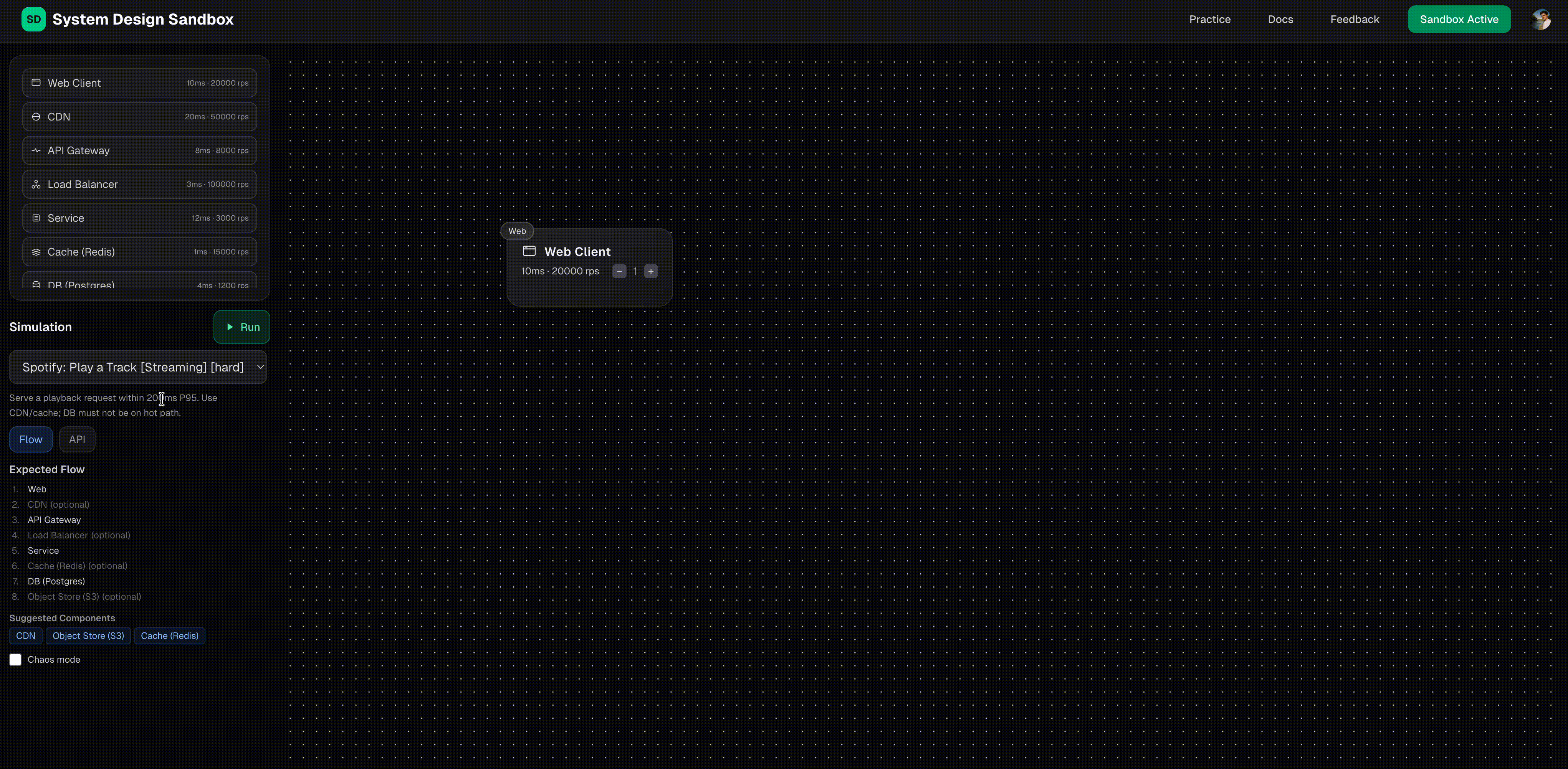Ace Your System Design InterviewInteractive Practice & Tutorials
Learn distributed systems, scalability patterns, and architecture design through hands-on practice. Drag components, simulate production architectures, and get instant feedback on your designs.
STEP 01
Pick a Scenario
Choose from real-world challenges with clear requirements: target latency, RPS capacity, and success criteria. Each scenario is designed to teach specific system design patterns.
- Production-scale requirements (P95 latency, RPS targets)
- Real-world patterns (CDN, caching, load balancing)
- Clear success criteria for validation
STEP 02
Design Your Architecture
Drag components onto an infinite canvas and connect them to build your system. Each component has realistic performance characteristics based on industry standards.
- 9 component types: Web, CDN, API Gateway, Service, Redis, Postgres, S3, Kafka, Load Balancer
- Directional connections show data flow
- Pan and zoom to manage complex designs

STEP 03
Run Simulation & Get Feedback
Our simulation engine analyzes your architecture in real-time. Get instant feedback on performance, capacity, and bottlenecks without writing a single line of code.
- P95 latency calculations with component-level breakdown
- Capacity analysis and bottleneck identification
- SLO compliance validation
STEP 04
Learn & Iterate
Understand why your design works (or doesn't). Share your solutions with others or fork existing designs to learn different approaches to the same problem.
- Share via URL with compressed Base64 encoding
- Fork and modify existing solutions
- Compare different architectural approaches
Drag-and-Drop Canvas
Build architectures visually on an infinite grid. Place components and connect them with directional edges. Pan and zoom to manage complex designs.
Real-Time Simulation
Get instant feedback on P95 latency, capacity, and bottlenecks. Our simulation engine analyzes your design without requiring any code.
Production-Scale Scenarios
Practice with real-world requirements like Spotify Play (200ms P95, 2k RPS), URL Shortener (100ms, 5k RPS), and CDN Design (80ms, 8k RPS).
Share & Collaborate
One-click URL sharing with Base64 encoding. Fork existing designs to learn different approaches and compare solutions.
9 Component Types
Web, CDN, API Gateway, Service, Redis, Postgres, S3, Kafka, and Load Balancer. Each with realistic performance characteristics.
Mobile-Friendly
Touch gestures, bottom sheets, and responsive design. Practice system design anywhere, anytime on any device.
System Design Interview Practice Scenarios
Master real-world system design patterns with our interactive tutorials and examples
• Handle millions of requests per second
• Design efficient hashing algorithms
• Implement caching strategies
• Social media feed design
• Video streaming architecture
• Real-time messaging systems
• Architecture fundamentals
• Scalability techniques
• Interview preparation tips
Frequently Asked Questions
Everything you need to know about system design interview preparation
How do I prepare for a system design interview?
Start by practicing with interactive scenarios like our URL shortener tutorial. Focus on understanding distributed systems, scalability patterns, and architecture trade-offs. Practice designing systems end-to-end, from requirements gathering to capacity planning. Our platform provides instant feedback on your designs to accelerate learning.
What is system design and why is it important?
System design is the process of defining the architecture, components, and data flow of large-scale software systems. It's crucial for building scalable, reliable applications and is a key evaluation criterion in senior engineering interviews at top tech companies.
What are the most common system design interview questions?
Common questions include designing URL shorteners, social media feeds (Twitter/Instagram), video streaming platforms (Netflix/YouTube), messaging systems (WhatsApp), ride-sharing apps (Uber), and e-commerce sites (Amazon). Each teaches different scalability and architecture patterns.
How long does it take to learn system design?
With focused practice, you can learn core system design concepts in 4-8 weeks. Our interactive platform accelerates learning by providing hands-on practice with real-time feedback. Practice 3-4 scenarios per week to build strong fundamentals for your system design interview.
Is System Design Sandbox free to use?
Yes! System Design Sandbox is completely free. We provide interactive tutorials, practice scenarios, and instant feedback at no cost. Our mission is to make high-quality system design education accessible to everyone preparing for technical interviews.
Ready to Ace Your System Design Interview?
Start practicing with real-world scenarios. No theory, just hands-on experience with instant feedback on your architectural decisions.